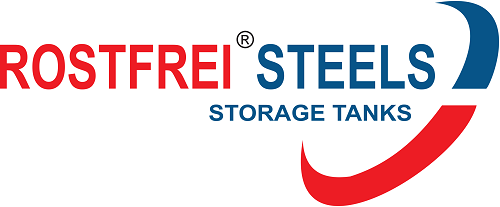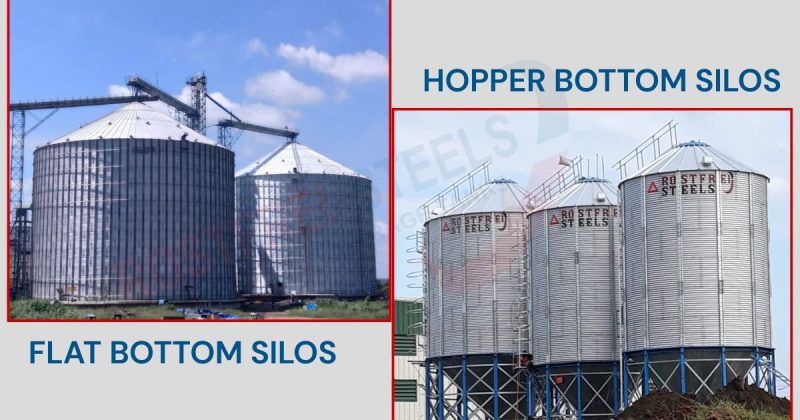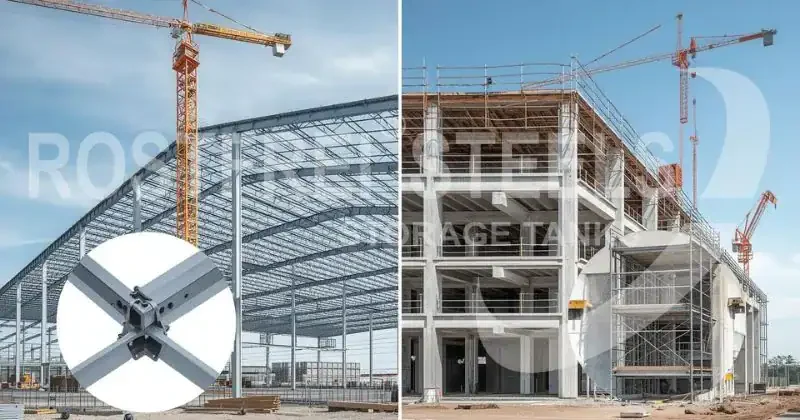What is the difference between hopper bottom silo and flat bottom silo?
When it comes to bulk material storage whether for grains, pulses, or animal feed choosing the right silo type is crucial. The two main types of silos used across industries are Flat Bottom Silos and Hopper Bottom Silos.
In this blog, we’ll compare Flat Bottom vs Hopper Bottom Silos highlighting their unique design features, advantages, and ideal use cases. Your choice will affect cost efficiency, discharge speed, and material safety.
We’ll help you understand the pros and cons of both silo types and guide you toward making the right choice for your storage operation.
What Are Silos and Why Does Bottom Design Matter?
A silo is a vertical storage structure designed to store bulk materials safely while maintaining quality and minimizing losses. When it comes to Flat Bottom vs Hopper Bottom Silos, the bottom design determines how efficiently materials flow out, how easy the silo is to clean, and how cost-effective it is over time.
Choosing between Flat Bottom vs Hopper Bottom Silos is more than just a design choice it’s a strategic decision that directly impacts your operation’s productivity and profitability.
Flat Bottom Silos: Long-Term Storage Experts
Design Overview
A flat bottom silo features a reinforced concrete base with vertical steel walls. The material is discharged through a central outlet, often assisted by mechanical reclaim systems such as sweep augers or chain conveyors.
Ideal For:
- Long-term grain storage
- Port terminals and industrial applications
Key Benefits
- High Storage Capacity: Perfect for storing thousands of tons of material economically.
- Durable & Stable: The concrete base ensures excellent load distribution.
- Best for Long-Term Preservation: Maintains grain quality over extended storage periods.
Limitations
- Slower discharge process
- Requires mechanical cleaning
- Not ideal for daily loading/unloading cycles
Hopper Bottom Silos: Designed for Efficiency
Design Overview
A hopper bottom silo has a conical steel base, typically mounted on a steel frame or legs. The cone’s steep angle allows materials to flow freely by gravity, eliminating the need for internal reclaim systems.
Ideal For:
- Feed mills and breweries
- Short-term or high-turnover grain storage
- Plastic pellets, or pellets storage
Key Benefits
- Fast, Gravity-Driven Discharge: Reduces time and mechanical effort.
- Low Maintenance: No moving discharge parts like augers.
- Self-Cleaning Design: No residue after unloading.
- Perfect for Frequent Batches: Great for facilities with multiple product types or frequent material changes.
- More Economical Civil Foundation costs
Limitations
- Smaller storage capacity compared to flat bottom silos
- Requires steel supports or elevated foundations
Flat Bottom vs. Hopper Bottom Silo: Key Differences
Feature | Flat Bottom Silo | Hopper Bottom Silo |
Base Design | Flat concrete floor | Conical (funnel-shaped) steel bottom |
Discharge Method | Mechanical (sweep auger) | Gravity flow |
Storage Capacity | Large (up to 15,000 tons or more) | Small to medium (50–1,000 tons) |
Ideal Use | Long-term, bulk storage | Short-term, high-turnover operations |
Maintenance | Moderate | Low |
Cleaning | Requires mechanical cleaning | Self-cleaning by gravity |
Construction Cost | Lower for large capacity | Higher Cost as compare to similar capacity Flat bottom due to additional Steel Support structures |
Foundation | Concrete base | Concrete pillars over Ring beam foundation- Hence more cost effective |
Common Materials Stored | Grain reserves | Grains,Seeds, pellets, animal feed, malt |
Applications of Each Silo Type
Flat Bottom Silo Applications
- Grain terminals and food reserves
- Flour and feed mills
- Ports and bulk handling hubs
Hopper Bottom Silo Applications
- Seed processing and pellet storage
- Breweries and malt facilities
- Short-term grain collection points , or storage requiring high turnover of grains
Key Factors to Consider Before Choosing
Storage Volume
- Flat bottom silos: best for large-scale storage.
- Hopper bottom silos: best for smaller capacities or day silos.
Discharge Frequency
- For occasional unloading, choose flat bottom silos.
- For frequent discharge or high turnover, hopper silos are ideal.
Material Type
- Free-flowing materials (corn, pellets): Flat bottom silo.
- Cohesive materials (flour, DOC): Hopper bottom silo with bin activators
Site & Space Constraints
- Flat bottom requires large foundation area.
- Hopper silos need elevated platforms but occupy less footprint.
Budget
- Flat bottom: lower cost per ton stored
- Hopper bottom: higher upfront cost, lower maintenance cost.
Engineering Considerations
Material of Construction
- Galvanized steel: corrosion resistance and long service life
- Concrete: excellent for temperature stability and large silos
Hopper Angle
- The cone angle (40°–60°) depends on the material’s flowability.
- Steeper angles reduce clogging and improve discharge efficiency.
Safety & Monitoring Systems
- Temperature Sensors
- Level sensors
- Humidity Sensor
Proper instrumentation ensures safe storage and consistent product quality.
Cost Comparison: Flat Bottom vs. Hopper Bottom Silos
Parameter | Flat Bottom | Hopper Bottom |
Initial Cost | Lower for large capacity | Higher for small capacity |
Foundation Cost | Concrete base (moderate) | Concrete pillars over ring beam (lower) |
Operational Cost | Moderate (maintenance of augers) | Low (gravity flow) |
Cleaning & Downtime | Slightly higher | Minimal |
Payback Period | Longer (for storage reserves) | Shorter (for turnover operations) |
- Flat bottom silos → Best ROI for large, static storage systems
- Hopper bottom silos → Best ROI for flexible, daily-use systems
Expert Recommendation
For most facilities, the ideal setup combines both silo types:
- Flat Bottom Silos for long-term storage
- Hopper Bottom Silos for processing and daily dispatch
This hybrid approach optimizes both capacity and efficiency, reducing downtime while maximizing throughput.
Conclusion
Choosing between a flat bottom silo and a hopper bottom silo depends on your storage goals, material type, and budget.
- For large, long-term storage → Choose Flat Bottom Silo
- For quick discharge and flexibility → Choose Hopper Bottom Silo
Both types can be integrated with modern automation and aeration systems to improve quality control and reduce operational costs.
Whether you’re expanding a grain storage facility, upgrading a feed mill, or setting up a bulk handling unit, the right silo design can significantly improve efficiency, safety, and profitability.




